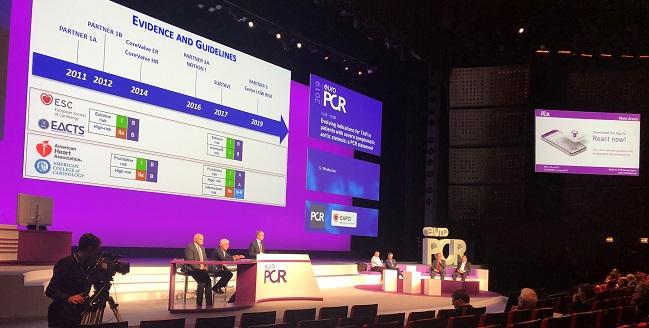TAVR’s Benefit Across ‘Spectrum of Risk’ Supports Paradigm Shifts, Says EuroPCR Statement
A new meta-analysis combining all of the randomized TAVR versus SAVR trials shows that the benefits of transcatheter span the range of risk.

PARIS, France—Evidence across the range of risk studied in TAVR trials to date supports a series of “paradigm shifts” in the approach to patients with aortic stenosis, according to Stephan Windecker, MD (Bern University Hospital, Switzerland), who presented a EuroPCR position statement here.
TAVI’s superior clinical performance compared with surgical aortic valve replacement (SAVR) has now been demonstrated across the spectrum of risk, said Windecker, citing a recent meta-analysis of all randomized trials. “Surgical risk estimation is no longer the basis to guide the choice between TAVI and SAVR,” he said.
In the main arena Thursday, Windecker presented highlights from the meta-analysis, which was published online ahead of print in the European Heart Journal with first author George Siontis, MD, PhD (Bern University Hospital). The study combines the more than 8,000 patients who have been studied to date in the seven randomized controlled trials, ranging from the earliest high-risk trials to the recently released PARTNER 3 and the Evolut TAVR in Low-Risk Patients studies.
“Across the entire spectrum of surgical risk,” Windecker said, and regardless of valve type, TAVR was associated with a significant reduction in all-cause mortality as compared with SAVR (HR 0.88; 95% CI 0.78-0.99). Another key, patient-centered outcome, stroke, also favored TAVR over SAVR (HR 0.81; 95% CI 0.68-0.98). Major vascular complications (HR 1.99; 95% CI 1.34-2.93), however, as well as permanent pacemaker implantations, were higher in TAVR-treated patients (HR 2.27; 95% CI 1.47-3.64).
In an analysis looking only at transfemoral procedures, Windecker continued, mortality was reduced by 17% out to 2 years with TAVR versus SAVR (HR 0.83; 95% CI 0.72-0.94). Hospital resource use is also substantially lessened with the transcatheter procedures, Windecker said, including reduced procedure times, intensive care unit stays, and total hospital stays.
TAVR as Default
Given the consistency of these findings across all levels of patient risk, TAVR should now be the default strategy, with a heart team weighing the clinical and anatomical characteristics to choose the best treatment option for individual patients, the EuroPCR statement concludes. Such an approach should take into account life expectancy and valve durability, Windecker emphasized. A number of “uncertainties and opportunities” remain, however, including valve durability, treatment of bicuspid valve disease, management of younger patients, treatment of concomitant coronary artery disease, and best antithrombotic strategy.
If Mick Jagger opts for TAVR, and he’s a low-risk TAVR [candidate] and we see that outcome, why would you withhold that therapy from anybody else? Stephan Windecker
Indeed, based on the assumption that regulators will extend the indication for TAVR to low-risk patients, coronary interventionalists have voiced concerns that younger and younger patients will end up undergoing transcatheter replacement, and that this might impact the ability to access and treat coronary lesions down the road. But asked about this during a EuroPCR press conference, Windecker pointed out that any patient being considered for TAVR would also be worked up for concomitant coronary artery disease and managed accordingly at that time. Moreover, the age of manifestation of relevant coronary artery disease “is typically in the 60s,” Windecker said, whereas aortic stenosis usually “lags” behind.
“If you arrive at aortic stenosis without CAD, then the likelihood that you will develop CAD is rather low,” Windecker told TCTMD. “But, we have all those patients who have had coronary artery disease and who subsequently develop aortic stenosis, and there, certainly, accessibility to the coronaries is an issue, and that is something we need to tease out in the future: what is the appropriate valve for which patient and disease condition?”
“At the end of the day, what you really should do is put the patient at the center of the decision-making,” he said. And here the question will be more about what is the best prosthesis and what is the best technique and not a simplistic TAVR versus SAVR discussion.
“The important thing to realize is that the default in the future will be TAVR. The patients will not accept that this therapy could be withheld,” Windecker said. “If Mick Jagger opts for TAVR, and he’s a low-risk TAVR [candidate] and we see that outcome, why would you withhold that therapy from anybody else?”
Shelley Wood was the Editor-in-Chief of TCTMD and the Editorial Director at the Cardiovascular Research Foundation (CRF) from October 2015…
Read Full BioSources
Siontis GCM, Overtchouk P, Cahill TJ, et al. Transcatheter aortic valve implantation vs. surgical aortic valve replacement for treatment of symptomatic severe aortic stenosis: an updated meta-analysis. Eur Heart J. 2019;Epub ahead of print.
Disclosures
- Windecker reports receiving educational and research contracts to his institution from Amgen, Abbott, BMS, Bayer, Boston Scientific, Biotronik, Medtronic, Edwards Lifesciences, CSL, Polares, and Sinomed.


Comments